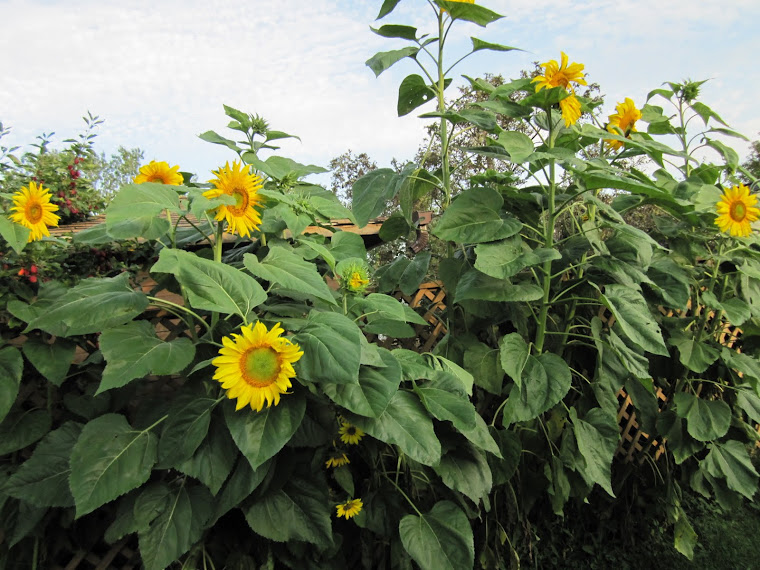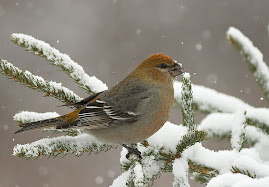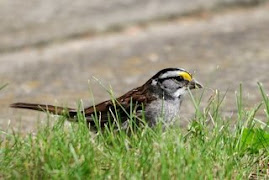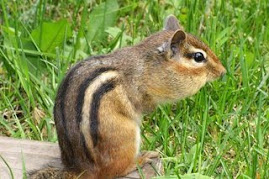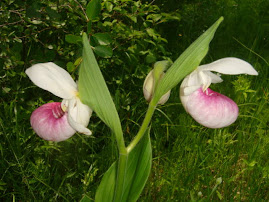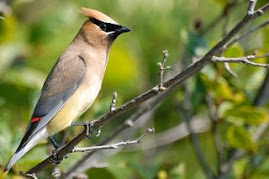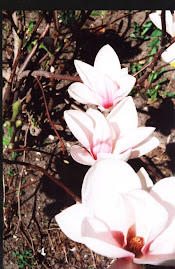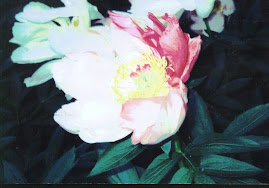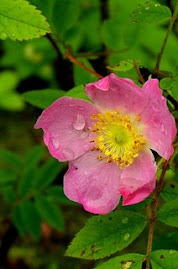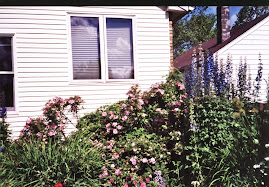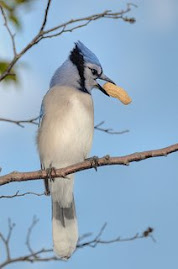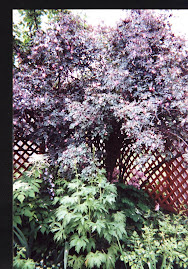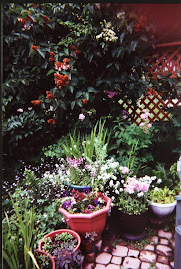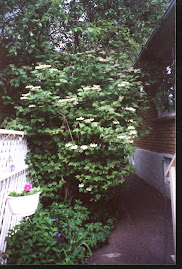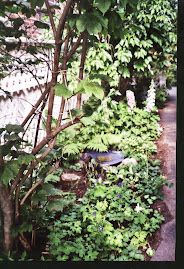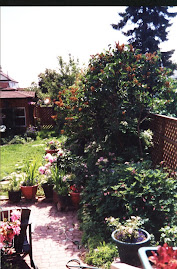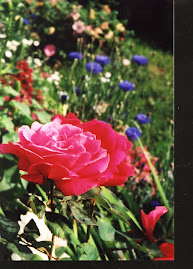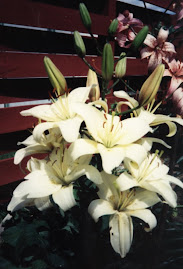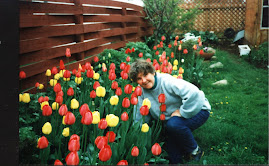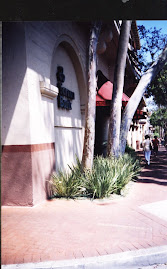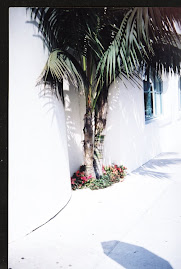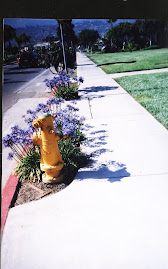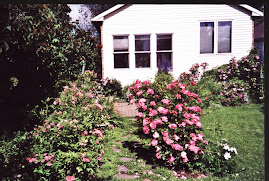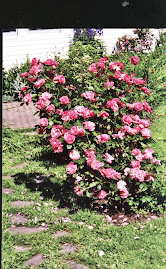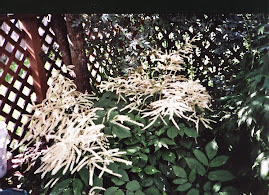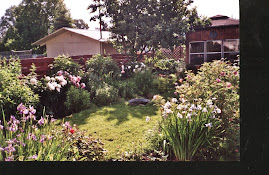Yesterday was a wonderful day to work in the garden. Every warm and sunny day is precious now. As I puttered about the white-throated sparrows sang their autumn song composed of a few faint whistles quite diferent from the spring song of I-love-Ca-na-da,Ca-na-da, Ca-na-da. The autumn song is a faint echo but like many Canadians the white throats will spend the winter in warmer places.
I cleaned pots and boxes and planted the Orienpet lilies deep in a spot near the patio. All summer they grew in a big planter box and produced large flower heads. But as pot plants they were not entirely successful. They leaned this way and that and the blooms were down facing so you could not really see them unless you were close enough to peek under the petals. I have to think what to put into the big cedar box next year.
I see the lavatera is about finished for the year but the tiny lemon gem marigolds bloom magnificantly on. The tall nicotania is really coming into its own now. A spindly plant all summer, it sprang into bloom about a month ago and still carries on. This old fashioned variety sports thin white trumpet shaped flowers. During the summer, I vowed never to plant it again but now I am rethinking.
In spite of he heavy rain of a few days ago, the compost in the black composter was dry. The lid keeps out rain and that does not encourage what we want - i.e. rot. The lid comes off for the season.
A friend in the country cut down her lovely apple tree. Every year it was attacked by a bear who left behind broken branches and no apples. In the city the apples attract the apple maggot fly and in the country, bears.
This year I bought grand apples at the farmers' market, my favourite Saturday destination. And I am not alone. The place is jammed at the opening bell at 8 a.m. I got another basket of blueberries, perhaps the last of an excellent season.
Monday, 29 September 2008
Saturday, 27 September 2008
AUTUMN GARDEN
Becky Klein McCreary is a poet and gardener in the tiny town of Ouray, Colorado. Her poem expresses the sadness we feel when the garden disappears for the winter.
Autumn Garden
I am not ready
to put you away from chilling winds
into darkness
or slice into the stubby cuttings
for next year’s garden
or let trespassing deer
bite your tall, green crown
down to the brown soil
or stuff you into clay pots
that by mid-April
I have begun to dislike
Because you are too needy.
Lime green hostas
orphaned on our porch
grew plump this summer
in Box Elder’s shade
Thorny cactus, carefully cut
from ragged New Mexico ditches
lean out of terra-cotta pots.
Peppermint, lemon balm
chocolate mint, apple mint
garnished summer fruit bowls
and glasses of iced tea.
Oregano, thyme, and parsley
gathered into faded rag ribbons
drying for winter pasta dishes
cascading catnip, out of reach
sends kitty into a frenzy
while green-red hens and chicks
playfully tumble off the rocky roosts.
Feathery, copper fennel
waves in a wisp of wind
and daisies, coneflowers, yarrow
bow in their final performance.
I don’t want to put you away.
Autumn Garden
I am not ready
to put you away from chilling winds
into darkness
or slice into the stubby cuttings
for next year’s garden
or let trespassing deer
bite your tall, green crown
down to the brown soil
or stuff you into clay pots
that by mid-April
I have begun to dislike
Because you are too needy.
Lime green hostas
orphaned on our porch
grew plump this summer
in Box Elder’s shade
Thorny cactus, carefully cut
from ragged New Mexico ditches
lean out of terra-cotta pots.
Peppermint, lemon balm
chocolate mint, apple mint
garnished summer fruit bowls
and glasses of iced tea.
Oregano, thyme, and parsley
gathered into faded rag ribbons
drying for winter pasta dishes
cascading catnip, out of reach
sends kitty into a frenzy
while green-red hens and chicks
playfully tumble off the rocky roosts.
Feathery, copper fennel
waves in a wisp of wind
and daisies, coneflowers, yarrow
bow in their final performance.
I don’t want to put you away.
Thursday, 25 September 2008
Serendipity
As I was writing the post below about bulbs, a neighbour dropped by. He had been cleaning out a basement and had several dozen clay flower pots and plant saucers to give away. I was out of the house like a shot.
Many people do not like ceramic flower pots. When filled with soil and plants, they are heavy. The large ones are chiropractor's dreams. Clay pots cannot be left outside in our winter because you end up with clay shards. It is a chore to empty the large ones, lug inside, scrub them and store. Plastic is easier, cheaper and preferred nowadays.
However, the old fashioned clay pots have virtues. They are often more attractive than plastic, with fancy colours and embosssed designs. The terra cotta colour gives a traditional look to the garden. They are a better bet for indoor forcing. They retain moisture better than plastic and, more importantly, if the tulip or daffodil stretches, they do not tip.
I sanffled up a tall pot, perfect for amaryllis. These plants are notorious tippers as they stretch in the low light conditions of mid-winter. I also took four six-inch pots for my hyacinth bulbs and a squat pot with saucer to match, perfect for forcing crocus.
Four large plant saucers were a bonus. Two became bird baths, replacing the plastic saucers that have been chewed up by the weed whacker. Two will go under the palm tree and the fig in the porch, once I get around to repotting these monsters.
Tip. If the clay pot breaks or cracks, recycle. Throw it hard against something so it breaks, gather up the shards and use them for drainage when planting pots. I have a small shard collection in the basement to use when planting bulbs for forcing and a larger collection in the back shed for next spring. I also recycle any broken household dishes for drainage shards.
Many people do not like ceramic flower pots. When filled with soil and plants, they are heavy. The large ones are chiropractor's dreams. Clay pots cannot be left outside in our winter because you end up with clay shards. It is a chore to empty the large ones, lug inside, scrub them and store. Plastic is easier, cheaper and preferred nowadays.
However, the old fashioned clay pots have virtues. They are often more attractive than plastic, with fancy colours and embosssed designs. The terra cotta colour gives a traditional look to the garden. They are a better bet for indoor forcing. They retain moisture better than plastic and, more importantly, if the tulip or daffodil stretches, they do not tip.
I sanffled up a tall pot, perfect for amaryllis. These plants are notorious tippers as they stretch in the low light conditions of mid-winter. I also took four six-inch pots for my hyacinth bulbs and a squat pot with saucer to match, perfect for forcing crocus.
Four large plant saucers were a bonus. Two became bird baths, replacing the plastic saucers that have been chewed up by the weed whacker. Two will go under the palm tree and the fig in the porch, once I get around to repotting these monsters.
Tip. If the clay pot breaks or cracks, recycle. Throw it hard against something so it breaks, gather up the shards and use them for drainage when planting pots. I have a small shard collection in the basement to use when planting bulbs for forcing and a larger collection in the back shed for next spring. I also recycle any broken household dishes for drainage shards.
Wednesday, 24 September 2008
THE BULBS ARE HERE
On Sunday I took a trip to Vanderwees to check out the fall bulbs.
Usually I buy Darwin tulips from the bins but, alas, no Darwins in the bins, only Triumphs. Darwins are the hardiest tulips for fall planting in the North. They are tall big-headed plants in many colours and, in other years, Vanderwees has offered two or three varieties in bins, running about fifty cents (or less) a bulb, significantly cheaper than the packaged Darwins which can cost up to a dollar a bulb.
Triumph tulips are shorter (usually) and good for forcing. This year I am concentrating on hyacinths for forcing and so I purchased a four-pack of Delph Blue. Nothing can surpass the gorgeous colour of blue hyacinths or the scent. A hyacinth makes a good, long blooming gift unlike tulips which pot out quickly. Hyacinths are not cheap and run about $1.75 a bulb.
Lily tulips intrigue me. They usually bloom late in long pointy flower heads. I bought a pack of sixteen mixed colours. ($9.99 or about 65 cents a bulb). These are fairly short tulips at 20 inches and so will probably come in at 15 inches in our climate. Unfortunately, lily tulips seldom return in future years – a one-off plant..
My main aim was to get allium gigantium bulbs. From experience, I know these sell out fast. This ornamental is a must for northerners. In the early spring, before most perennials have gathered themselves together, a tall flower spike emerges reaching 100 centimeters of more. Pale purple florets create a flower head bigger than a soft ball and long lasting too. I planted my first alliums in 1992 and they are still alive. Every year I add a bulb or two. The bulbs are not cheap. Vanderwees has them on sale for 4$ each, the best price I have seen for a while. I have seen prices as high as $8 a bulb. I bought four bulbs at this good price. I will set them at the back of the perennial bed with a good deep stake to mark the spot. Tip: There are many different types of allium but only the variety “gigantium” creates the tall spikes. Other alliums are floppy short things.
Vanderwees’ flyer advertised blue poppies, an intriguing idea and I bought a package of twenty-five ($6.99). I’ll plant then in a big clump and put another strong stake to mark the spot.
My final purchase was a pack of muscari also called grape hyacinth. I love the little bulbs and the blue muscari are as reliable in spring as the mosquitoes. This new variety, Spring Smile, promises flower heads a little larger than usual.
Vanderwees threw in a pack of King Alfred daffodils. I usually have zero luck with daffs, even this old-timey variety. However, this year, they go in deep, deep with a good mulch of leaves.
But for now, the bulbs go into the cold room until mid October. It is still too warm to plant them
Tip: When marking fall plantings use a strong stake or short metal pole and hammer it in. Keep notes of what stake marks what. The frost ejects plastic plant markers and the north wind erases written labels.
Usually I buy Darwin tulips from the bins but, alas, no Darwins in the bins, only Triumphs. Darwins are the hardiest tulips for fall planting in the North. They are tall big-headed plants in many colours and, in other years, Vanderwees has offered two or three varieties in bins, running about fifty cents (or less) a bulb, significantly cheaper than the packaged Darwins which can cost up to a dollar a bulb.
Triumph tulips are shorter (usually) and good for forcing. This year I am concentrating on hyacinths for forcing and so I purchased a four-pack of Delph Blue. Nothing can surpass the gorgeous colour of blue hyacinths or the scent. A hyacinth makes a good, long blooming gift unlike tulips which pot out quickly. Hyacinths are not cheap and run about $1.75 a bulb.
Lily tulips intrigue me. They usually bloom late in long pointy flower heads. I bought a pack of sixteen mixed colours. ($9.99 or about 65 cents a bulb). These are fairly short tulips at 20 inches and so will probably come in at 15 inches in our climate. Unfortunately, lily tulips seldom return in future years – a one-off plant..
My main aim was to get allium gigantium bulbs. From experience, I know these sell out fast. This ornamental is a must for northerners. In the early spring, before most perennials have gathered themselves together, a tall flower spike emerges reaching 100 centimeters of more. Pale purple florets create a flower head bigger than a soft ball and long lasting too. I planted my first alliums in 1992 and they are still alive. Every year I add a bulb or two. The bulbs are not cheap. Vanderwees has them on sale for 4$ each, the best price I have seen for a while. I have seen prices as high as $8 a bulb. I bought four bulbs at this good price. I will set them at the back of the perennial bed with a good deep stake to mark the spot. Tip: There are many different types of allium but only the variety “gigantium” creates the tall spikes. Other alliums are floppy short things.
Vanderwees’ flyer advertised blue poppies, an intriguing idea and I bought a package of twenty-five ($6.99). I’ll plant then in a big clump and put another strong stake to mark the spot.
My final purchase was a pack of muscari also called grape hyacinth. I love the little bulbs and the blue muscari are as reliable in spring as the mosquitoes. This new variety, Spring Smile, promises flower heads a little larger than usual.
Vanderwees threw in a pack of King Alfred daffodils. I usually have zero luck with daffs, even this old-timey variety. However, this year, they go in deep, deep with a good mulch of leaves.
But for now, the bulbs go into the cold room until mid October. It is still too warm to plant them
Tip: When marking fall plantings use a strong stake or short metal pole and hammer it in. Keep notes of what stake marks what. The frost ejects plastic plant markers and the north wind erases written labels.
Monday, 22 September 2008
Autumn Tips
A reader, Anne Marie, wants to add some advice on mouse proofing a garden shed for the winter. She says to remove all rags or paper products that mice could shred to make a nest. She once left a roll of paper towel in her shed and the mice reduced it to tiny scraps. They also shredded up some plastic bags.
James Z. mentions that skunks target garden sheds. City skunks often hibernate in a burrow dug under a building. A row of bricks around the base of a shed or garage can prevent then from digging in. If they are a smelly nuisance, you might want to leave a light burning outside all night. Skunks do not like light.
I pull up the veggie garden and find more cucumber, squash and zucchini. I bring them inside, wipe them dry and set them out so that they do not touch each other. I'll give some away, if I can, and make soup with the rest.
On a trip to the Upper Peninsula of Michigan I was startled to see shredded cypress bark on sale as garden mulch. The Audubon Society is requesting that cypress bark be banned. They urge gardeners to boycott cypress bark mulch. Huge sections of southern Louisiana cypress forest are being cut for bark. Cyprus is a native tree in the south. It withstands hurricanes very well and prevents hurricane flood surges. Several large chains including Wal-Mart have discontinued cypress bark. Home Depot however still carries it.
Grackles have arrive in my garden and it is as if the biker gang of the birder world has dropped by. The smaller birds, chickadees, sparrows and goldfinches, sit in the lilacs and stay out of the way. I have to remind myself that grackles eat slugs and I cheer as they patrol the flower beds. Soon they will bully their way down south. Still I prefer the gold finches. Chipping and white throated sparrows join in with the house sparrows at the feeders. A fox sparrow scratches the ground with both feet together, digging up edibles. Only the chickadees and the house sparrows will stay around for the winter. I have never seen a whiskey jack in my yard even though they appear at feeders in gardens close to McVicar's Creek. The blue jays of last week seem to have moved on.
Winter energy cake for birds. Ingredients: equal parts corn meal (from the bulk store), lard and peanut butter. Melt the lard and peanut butter and stir in the corn meal. The mixture should be thick but still runny. Drop ladles of this mixture on to waxed paper covered cookie sheets and put in the freezer. When the "cookies" are frozen, put in a bag or container and keep in the freezer. Jam a couple of cookies into a wire holder. Birds love this fat cake and this recipe is cheaper than buying the commercial bird cakes. I look for lard and peanut butter on sale and buy in bulk.
The bulbs are back!! I trek out to Vanderwees and buy. More next post.
James Z. mentions that skunks target garden sheds. City skunks often hibernate in a burrow dug under a building. A row of bricks around the base of a shed or garage can prevent then from digging in. If they are a smelly nuisance, you might want to leave a light burning outside all night. Skunks do not like light.
I pull up the veggie garden and find more cucumber, squash and zucchini. I bring them inside, wipe them dry and set them out so that they do not touch each other. I'll give some away, if I can, and make soup with the rest.
On a trip to the Upper Peninsula of Michigan I was startled to see shredded cypress bark on sale as garden mulch. The Audubon Society is requesting that cypress bark be banned. They urge gardeners to boycott cypress bark mulch. Huge sections of southern Louisiana cypress forest are being cut for bark. Cyprus is a native tree in the south. It withstands hurricanes very well and prevents hurricane flood surges. Several large chains including Wal-Mart have discontinued cypress bark. Home Depot however still carries it.
Grackles have arrive in my garden and it is as if the biker gang of the birder world has dropped by. The smaller birds, chickadees, sparrows and goldfinches, sit in the lilacs and stay out of the way. I have to remind myself that grackles eat slugs and I cheer as they patrol the flower beds. Soon they will bully their way down south. Still I prefer the gold finches. Chipping and white throated sparrows join in with the house sparrows at the feeders. A fox sparrow scratches the ground with both feet together, digging up edibles. Only the chickadees and the house sparrows will stay around for the winter. I have never seen a whiskey jack in my yard even though they appear at feeders in gardens close to McVicar's Creek. The blue jays of last week seem to have moved on.
Winter energy cake for birds. Ingredients: equal parts corn meal (from the bulk store), lard and peanut butter. Melt the lard and peanut butter and stir in the corn meal. The mixture should be thick but still runny. Drop ladles of this mixture on to waxed paper covered cookie sheets and put in the freezer. When the "cookies" are frozen, put in a bag or container and keep in the freezer. Jam a couple of cookies into a wire holder. Birds love this fat cake and this recipe is cheaper than buying the commercial bird cakes. I look for lard and peanut butter on sale and buy in bulk.
The bulbs are back!! I trek out to Vanderwees and buy. More next post.
Sunday, 21 September 2008
Love those Roses and other Autumn Thoughts
The joy of roses. The Morden Snowberry is covered in floppy white blooms, the inestimable Winnipeg Parks is still producing one hot magenta rose after another and the Explorers bring out a few pink blossoms every week. The rose hips will attract birds later in the winter but for now the bright red hips of the Red Leafed Rose are as brilliant as flowers. Around town, many Hansa Roses are still blooming albeit weakly. Their leaves will be the last things to drop with the frost, expected any day now.
This is also PG Hydrangea time. These shrubs are aThunder Bay fav. and every garden should have one just to pick up the spirits this time of year. Many people buy Annabelle hydrangeas with their enormous flower heads but they need winter protection and even so....
My garden is full of birds plus the odd squirrel. I heard that a Thunder Bay guy has been trapping the big black squirrels and releasing them out of town. Is this legal? I hope so. I prefer the tiny native red guys over the muscle bound Toronto newcomers.
There are so many birds around I've set up a fourth bird bath. By far, the birds prefer baths on the ground and they like the blue ceramic saucer the best. Perhaps the colour attracts them. My new bath is a child's snow saucer, purple in colour. I have also bought a device that keeps the water moving in a bird bath. This repels mosquitoes who lay eggs in stagnant water and attracts birds who are attracted to moving water.
I have started to move the bird feeders closer to the house so that they can be seen from the porch window in the winter.
I will also put out the bird bath heater and leave it for a few months. But once it gets really cold (below minus fifteen or so) the heater will not work and the bath freezes solid. Even a kettle of boiling water doesn't do much good.
I have made some high energy seed cakes to put out in the special holders once the frosts sets in. Recipe next post.
Tip: If you believe in prayer, say one to the goddess of gardens for early and deep snow for all northern gardens. Perform a hex to keep away the devil's work - no snow and the mercury deep down in the thermometer's socks.
This is also PG Hydrangea time. These shrubs are aThunder Bay fav. and every garden should have one just to pick up the spirits this time of year. Many people buy Annabelle hydrangeas with their enormous flower heads but they need winter protection and even so....
My garden is full of birds plus the odd squirrel. I heard that a Thunder Bay guy has been trapping the big black squirrels and releasing them out of town. Is this legal? I hope so. I prefer the tiny native red guys over the muscle bound Toronto newcomers.
There are so many birds around I've set up a fourth bird bath. By far, the birds prefer baths on the ground and they like the blue ceramic saucer the best. Perhaps the colour attracts them. My new bath is a child's snow saucer, purple in colour. I have also bought a device that keeps the water moving in a bird bath. This repels mosquitoes who lay eggs in stagnant water and attracts birds who are attracted to moving water.
I have started to move the bird feeders closer to the house so that they can be seen from the porch window in the winter.
I will also put out the bird bath heater and leave it for a few months. But once it gets really cold (below minus fifteen or so) the heater will not work and the bath freezes solid. Even a kettle of boiling water doesn't do much good.
I have made some high energy seed cakes to put out in the special holders once the frosts sets in. Recipe next post.
Tip: If you believe in prayer, say one to the goddess of gardens for early and deep snow for all northern gardens. Perform a hex to keep away the devil's work - no snow and the mercury deep down in the thermometer's socks.
Thursday, 18 September 2008
Cooking with your garden produce
Here is a delicious and simple soup that uses either cucumbers, squash or a mixture of both. It can be eaten hot or cold. I prefer hot.
Barbara B's Cucumber Soup
Take a few garden cukes, peel and chunk up. You can use the pickling cukes if you grow them. or chunk up some peeled squash of any sort. Chop up a big onion and put all in pot and add broth to cover. (I use non-salt veggie cubes to make broth but Barbara uses chicken broth cubes)Simmer until cooked. The cooking time depends on what combo you have in the pot but about 15 minutes should do it. Salt and pepper. Add a bit of fresh dill. if you grow it. I added a shake of cajun spice. Cool the soup and puree well in a blender or food processor. Place in a container and put in fridge. This is your basic soup.
To serve, take out about two thirds cup for each person and combine with a third cup of bettermilk. Serve hot or cold. That's it. How easy can it get?
Tip. We often get our first frost on September 20. Last year it was much later. Often the perennials bloom on, tough guys that they are. All the annuals which turn to black pulp have to be pulled and composted. I just leave the other plants alone. I empty my large ornamental ceramic pot, rinse it with the hose and bring it inside and scrub it. Slug eggs can hide in the rough ceramic material and so a good scrubing is needed. Ceramic pots will not survive outside in out deep freeze winters. I also pull the blackend annuals out of the large plastic pots and window boxes. Then it depends how much time I have. Sometimes I have emptied these containers on the compost but in a hurried autumn, I just leave them alone.
Barbara B's Cucumber Soup
Take a few garden cukes, peel and chunk up. You can use the pickling cukes if you grow them. or chunk up some peeled squash of any sort. Chop up a big onion and put all in pot and add broth to cover. (I use non-salt veggie cubes to make broth but Barbara uses chicken broth cubes)Simmer until cooked. The cooking time depends on what combo you have in the pot but about 15 minutes should do it. Salt and pepper. Add a bit of fresh dill. if you grow it. I added a shake of cajun spice. Cool the soup and puree well in a blender or food processor. Place in a container and put in fridge. This is your basic soup.
To serve, take out about two thirds cup for each person and combine with a third cup of bettermilk. Serve hot or cold. That's it. How easy can it get?
Tip. We often get our first frost on September 20. Last year it was much later. Often the perennials bloom on, tough guys that they are. All the annuals which turn to black pulp have to be pulled and composted. I just leave the other plants alone. I empty my large ornamental ceramic pot, rinse it with the hose and bring it inside and scrub it. Slug eggs can hide in the rough ceramic material and so a good scrubing is needed. Ceramic pots will not survive outside in out deep freeze winters. I also pull the blackend annuals out of the large plastic pots and window boxes. Then it depends how much time I have. Sometimes I have emptied these containers on the compost but in a hurried autumn, I just leave them alone.
Sunday, 7 September 2008
Mice are Not Nice
There is no such thing as one mouse. If you spot one, many others are lurking nearby. This time of year, the outdoor mice are looking for a winter berth, preferably one with food. It may be your back shed or it may be your house!
Last Christmas I bought large cans of popcorn on sale at Superstore, threw the popcorn in the garbage and kept the cans for bird food. These are stored in the shed and so far the mice have not nibbled into them. A friend stores her black oil sunflower seeds in a new metal garbage can with a good fitting top. Another stores her seeds in a big plastic pail with a flat lid held in place with a brick. I also sprinkle Critter Ridder (available at Canada Tire) around the shed floor. This is mainly to deter squirrels who also can nest in a shed.
Mice are notorious for getting into a building through a tiny crack or hole. Once in, they can do a lot of damage by nesting in the insulation or chewing on the electrical wires inside a stove. Mice can live under a dishwasher or under the kitchen floor joists and enter the kitchen at will through a gnawed hole in a lower cupboard.
The moral is to get rid of them at once.
A cat is best. I borrowed a cat the few times I have seen the droppings or heard the scritching in the evening. Other people rely on poison (not great if you have babies or pets around) or traps. I have used the live traps with success, baiting them with peanut butter. But the cat is the answer.
Last Christmas I bought large cans of popcorn on sale at Superstore, threw the popcorn in the garbage and kept the cans for bird food. These are stored in the shed and so far the mice have not nibbled into them. A friend stores her black oil sunflower seeds in a new metal garbage can with a good fitting top. Another stores her seeds in a big plastic pail with a flat lid held in place with a brick. I also sprinkle Critter Ridder (available at Canada Tire) around the shed floor. This is mainly to deter squirrels who also can nest in a shed.
Mice are notorious for getting into a building through a tiny crack or hole. Once in, they can do a lot of damage by nesting in the insulation or chewing on the electrical wires inside a stove. Mice can live under a dishwasher or under the kitchen floor joists and enter the kitchen at will through a gnawed hole in a lower cupboard.
The moral is to get rid of them at once.
A cat is best. I borrowed a cat the few times I have seen the droppings or heard the scritching in the evening. Other people rely on poison (not great if you have babies or pets around) or traps. I have used the live traps with success, baiting them with peanut butter. But the cat is the answer.
Tuesday, 2 September 2008
The Heat Goes On
The tomatoes should ripen in this heat even though the nights are cool now. I bought two plants, the variety called Early Girl, a lucky variety for me. But the rainy June and July held the plants back and the tomatoes are not even setting red yet. The rain did not harm the zucchini however. I was wise to just plant one plant. The corn (variety Northern X Sweet, from T&T seed of Winnipeg) is the best I have ever grown. I have been eating the cobs for two weeks now. The kernels are pale, straight and delicious. The cucumber is delicious too. For years I have grown the old fashioned eating type called Straight 8. The acorn squash is very small but I’m hoping it will plump up before a hard frost kills the leaves.
I am planning to raise my small veggie bed next year. I have plenty of compost to fill up a small area bordered by 2X6 planks. Even an inch or two of height gives protection from the frost.
I never liked the yellow potentilla bush but a few years ago I planted the white flowering variety and later the pale pink, each placed in the centre of a perennial bed and both blooming their hearts out now. Potentilla is as tough as an old boot and a lot prettier. It is one of the few plants that will winter over in a raised bed. Also deer do not eat them. Banff, a city plagued by elk, is awash in potentilla, the one garden item those huge pests do not eat. (And we think squirrels are a problem!).
The Lasagna Method is used to carve new garden spaces from the lawn without removing sod. The web provides everal recipes but the simplest is to put down several layers of newspaper and cover with compost and leave for a long time. The grass dies and you plant right through the paper which composts under the soil. I intend to try this out this fall and leave all in place over the winter. My front grass covers a impenetrable tangle of maple tree roots but maybe lasagna can give me some usable garden space. I am hoping the newspaper will stop the tree roots from taking over the compost as well as kill the grass. A small patch first, I think.
Tip. If you worry the shasta daisies will spread throughout your garden, be sure to pull off the flower heads before they set seed.
I am planning to raise my small veggie bed next year. I have plenty of compost to fill up a small area bordered by 2X6 planks. Even an inch or two of height gives protection from the frost.
I never liked the yellow potentilla bush but a few years ago I planted the white flowering variety and later the pale pink, each placed in the centre of a perennial bed and both blooming their hearts out now. Potentilla is as tough as an old boot and a lot prettier. It is one of the few plants that will winter over in a raised bed. Also deer do not eat them. Banff, a city plagued by elk, is awash in potentilla, the one garden item those huge pests do not eat. (And we think squirrels are a problem!).
The Lasagna Method is used to carve new garden spaces from the lawn without removing sod. The web provides everal recipes but the simplest is to put down several layers of newspaper and cover with compost and leave for a long time. The grass dies and you plant right through the paper which composts under the soil. I intend to try this out this fall and leave all in place over the winter. My front grass covers a impenetrable tangle of maple tree roots but maybe lasagna can give me some usable garden space. I am hoping the newspaper will stop the tree roots from taking over the compost as well as kill the grass. A small patch first, I think.
Tip. If you worry the shasta daisies will spread throughout your garden, be sure to pull off the flower heads before they set seed.
Subscribe to:
Comments (Atom)

